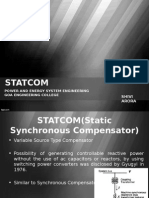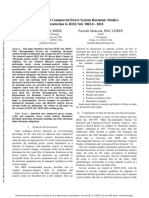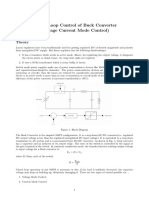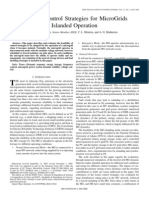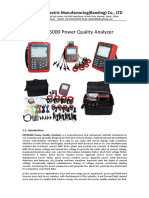Statcom Documentation
Uploaded by
balu_33babuStatcom Documentation
Uploaded by
balu_33babuSTATCOM
1.1 INTRODUCTION
Static Synchronous Compensator (STATCOM) is defined as a self commutated switching power converter supplied from an appropriate electric energy source and operated to produce a set of adjustable multiphase voltages, which may be coupled to an ac power system for the purpose of exchanging independently controllable real and reactive power. The STATCOM has been defined as per CIGRE/IEEE with following three operating structural components. First component is Static: based on solid state switching devices with no rotating components; second component is Synchronous: analogous to an ideal synchronous machine with 3 sinusoidal phase voltages at fundamental frequency; third component is Compensator: provided with reactive compensation [17]. (Or) A static synchronous generator operated as a shunt connected static VAR compensator whose capacitive or inductive current can be controlled independent of the AC system voltage[18].
Fig. 1.1 (a) Single line diagram of STATCOM
STATCOM is one of the key Converter-based Compensators which are usually based on the VSI or CSI.
Fig.1.1(b) VSC based Statcom
Fig.1.1(c) CSC based Statcom
VSC are often preferred over current sourced converters for FACTS applications. The STATCOM is composed of a VSC with a dc capacitor, coupling transformer, and signal generator and control circuit. Due to its versatile nature and speedy response, STATCOM finds a wide application in the field, both as a reactive power compensating device and harmonic absorber.
1.2 PRINCIPLE OF OPERATION:
The Basic principle of reactive power generation by a voltage-sourced converter is akin to that of the conventional rotating synchronous machine shown schematically in fig.1.2 (a). For purely reactive power flow, the three phase induced EMFs E a , E b and E c of the synchronous rotating machine are in phase with the system voltages V a , V b and V c . The reactive current I drawn by the synchronous compensator is determined by the magnitude of the system voltage V,
that of the internal voltage E, and the total circuit reactance (synchronous machine reactance plus transformer leakage reactance plus system short-circuit reactance) X.
Fig. 1.2 (a) Synchronous Condenser
(1-1) The corresponding reactive power Q exchanged can be expressed as follows:
(1-2) The STATCOM is basically a DC-AC voltage source converter with an energy storage unit, usually a DC capacitor. It operates as a controlled SVS connected to the line through a coupling transformer. Fig.1.2 (b) shows the schematic configuration of STATCOM. The controlled output voltage is maintained in phase with the line voltage, and can be controlled to draw either capacitive or inductive current from the line in a similar manner of a synchronous condenser, but much more rapidly. STATCOM is a primary shunt device of the FACTS family, which uses power electronics to control power flow and improve transient stability on power grids. The STATCOM regulates voltage at its terminals by controlling the amount of reactive
Power injected into or absorbed from the power system. The variation of reactive power is performed by means of a VSC connected on the secondary side of a coupling transformer. The VSC uses forced commuted power electronics devices (GTOs or IGBTs) to synthesize the voltage from a dc voltage source. The operating principle of STATCOM is explained in Fig.1.2 (b) .For computation purposes, we assume that the active and reactive power is transferred between two sources V1 and V2, where V1 represents the system voltage to be controlled and V2 is the voltage generated by the VSC. In steady state operation, the voltage V2 generated by the VSC is in phase with V1 (=0, angle of V1 with respect to V2) so that only the reactive power is flowing from V1 to V2; i.e. STATCOM is observing reactive power. It can be seen that if V 2 > V 1 then current I q flows from the counter to ac system through reactance and converter generates capacitive reactive power for ac system. On the other hand, if V 2 < V 1 then current Iq flows from ac system to the converter and converter absorbs inductive reactive power from ac system.
The amount of reactive power is given by:
(1-3)
A capacitor connected on the DC side of the VSC acts as a dc voltage source.
1.3 V-I AND V-Q CHARACTERISTICS:
The STATCOM is essentially an alternating voltage source behind a coupling reactance with the corresponding V-I and V-Q characteristics shown in fig.1.3 (a) and fig.1.3 (b). These show that STATCOM can be operated over its full output current range even at very low (theoretically zero), typically about 0.2 p.u. system voltage levels. In others words, the maximum capacitive or inductive output current of the STATCOM can be maintained independently of the ac system voltage, and the maximum VAR generation or absorption changes linearly with the AC system voltage.
Fig :-1.3(a) V-I Characteristics
Fig :-1.3(b) V-Q Characteristics
The STATCOM provides voltage support under large system disturbances during which the voltage excursions would be well outside of the linear operating range of the compensator. The capability of providing maximum compensating current at reduced system voltage enables the Statcom to perform in variety of applications. The VI and VQ characteristics illustrate, the Statcom may depending on the power semiconductors used have increased transient rating in both inductive and capacitive regions. The maximum attainable transient over current of the Statcom in the capacitive region is determined by the maximum current turn of capability of the power semiconductors (GTO) employed. The transient current rating of the Statcom in the inductive range is theoretically limited only by the maximum permissible e GTO junction temperature, which would in principle allow the realization of a higher transient rating in this range than that attainable in the capacitive range. However, it could be pointed out that this possibility would generally not exist if the converter poles were operated to produce a pulse width modulated waveform when the current conduction between the upper and lower values is transferred several times during each fundamental half cycle. Even with the non-PWM converters abnormal operating conditions should be carefully considered in the implementation of transient ratings above the peak turn off current capability of the semiconductors employed, because if an expected natural commutation would be missed for any reason converter failure requiring a forced shut down would likely occur.
APPLICATIONS OF STATCOM
2.1 APPLICATIONS OF STATCOM
The STATCOM has the following applications in controlling power system dynamics.
1. Damping of power system oscillations 2. Damping of subsynchronous oscillations 3. Balanced loading of individual phases 4. Reactive compensation of AC-DC converters and HVDC links 5. Improvement of transient stability margin 6. Improvement of steady-state power transfer capacity 7. Reduction of temporary over-voltages 8. Effective voltages regulation and control 9. Reduction of rapid voltages fluctuations (flicker control)[4].
TYPES OF CONTROL OF STATCOM
3.2 Open loop characteristics of STATCOM Model
Having the linearized system state space model as equation (3.9), we can use the linear system method to analyze the characteristics of STATCOM model. There are several open loop system properties we need to know before we design the controller. Although system observability and controllability are the properties of the system presentation, these are two important criterions that must be established before any attempt in controller design is done. These two characteristics of a system depend on the state space presentations of the system. For a given system, different state space presentations have different effects on the controller design algorithm. Another important property of a system is its open loop dynamic response characteristic that gives us not only the background information about the system performance but also the guideline for controller design.
1. Obsevability and Controllability The state space model of STATCOM has three state variables - i, , V. All of them can be measured from the power system, which means the system is observable.
You might also like
- Basic Electrical Mostly Asked 125 Questions and Answers60% (5)Basic Electrical Mostly Asked 125 Questions and Answers13 pages
- 19 - 231 - HVDC - 01 - Annex 5 - ETF HVDC (English) Rev.1No ratings yet19 - 231 - HVDC - 01 - Annex 5 - ETF HVDC (English) Rev.1116 pages
- A Transfer Function Approach To Harmonic Filter DesignNo ratings yetA Transfer Function Approach To Harmonic Filter Design15 pages
- Power Quality Issues of Distorted and Weak DistribNo ratings yetPower Quality Issues of Distorted and Weak Distrib20 pages
- Static Synchronous Compensator (Statcom)No ratings yetStatic Synchronous Compensator (Statcom)11 pages
- Shunt Compensation For Power Quality Improvement Using A Statcom ControllerNo ratings yetShunt Compensation For Power Quality Improvement Using A Statcom Controller5 pages
- VSC-FACTS-HVDC: Analysis, Modelling and Simulation in Power GridsFrom EverandVSC-FACTS-HVDC: Analysis, Modelling and Simulation in Power GridsNo ratings yet
- (Public) ABB Operational Experiences of STATCOMs For Wind ParksNo ratings yet(Public) ABB Operational Experiences of STATCOMs For Wind Parks12 pages
- Qdoc - Tips Dse Ingepac Ef LD Eng (35page)No ratings yetQdoc - Tips Dse Ingepac Ef LD Eng (35page)35 pages
- PSCAD EMTDC, FuzzyControl, HVDC Transmission, VoltageDependentCurrentOrderLimit VDCOLNo ratings yetPSCAD EMTDC, FuzzyControl, HVDC Transmission, VoltageDependentCurrentOrderLimit VDCOL9 pages
- PJM Dynamic Model Development GuidelinesNo ratings yetPJM Dynamic Model Development Guidelines45 pages
- SDG E Talega STATCOM Project System Analysis Design and ConfigurationNo ratings yetSDG E Talega STATCOM Project System Analysis Design and Configuration7 pages
- Industrial and Commercial Power System Harmonic Studies - Introduction To IEEE Std. 3002.8 - 2018No ratings yetIndustrial and Commercial Power System Harmonic Studies - Introduction To IEEE Std. 3002.8 - 201811 pages
- Metal Enclosed Switched Shunt Reactor BanksNo ratings yetMetal Enclosed Switched Shunt Reactor Banks13 pages
- A Method For Wind Farm Reactive Power Controlling Using DIgSILENT and MATLABNo ratings yetA Method For Wind Farm Reactive Power Controlling Using DIgSILENT and MATLAB16 pages
- 4-Hidroelectric Power Plants - Automation Using Iec 61850 - Experiences and Improvements For The User100% (1)4-Hidroelectric Power Plants - Automation Using Iec 61850 - Experiences and Improvements For The User23 pages
- The Study of Very Fast Transient Over Voltages (VFTO) For The Project of 400/220kV GIS Substation With One and Half Circuit Breaker ConfigurationNo ratings yetThe Study of Very Fast Transient Over Voltages (VFTO) For The Project of 400/220kV GIS Substation With One and Half Circuit Breaker Configuration4 pages
- STATCOM - Working Principle, Design and Application - Electrical ConceptsNo ratings yetSTATCOM - Working Principle, Design and Application - Electrical Concepts7 pages
- Simulation of Grounding Networks in The SES CDEGS Software: Antoni SzczepańskiNo ratings yetSimulation of Grounding Networks in The SES CDEGS Software: Antoni Szczepański6 pages
- IEEE - C37.04g - 1986 HV Circuit Breakers TestNo ratings yetIEEE - C37.04g - 1986 HV Circuit Breakers Test2 pages
- ABB Wind Turbine Converters: PCS6000, Full Power Converter, Up To 12 MWNo ratings yetABB Wind Turbine Converters: PCS6000, Full Power Converter, Up To 12 MW12 pages
- Optimal Placement of SVC and Statcom For Voltage Stability Enhancement Under Contingency Using Cat Swarm OptimizationNo ratings yetOptimal Placement of SVC and Statcom For Voltage Stability Enhancement Under Contingency Using Cat Swarm Optimization12 pages
- Harmonic Resonance During Energizing Primary Restorative Transmission SystemsNo ratings yetHarmonic Resonance During Energizing Primary Restorative Transmission Systems14 pages
- Power Factor Correction With Harmonic FiltersNo ratings yetPower Factor Correction With Harmonic Filters8 pages
- Failure Risk Analysis Under Switching Surges in Power Transmission SystemsNo ratings yetFailure Risk Analysis Under Switching Surges in Power Transmission Systems9 pages
- Defining Control Strategies For MicroGrids Islanded OperationNo ratings yetDefining Control Strategies For MicroGrids Islanded Operation9 pages
- ERCOT Reactive - Study - Guide - v10 - April2020No ratings yetERCOT Reactive - Study - Guide - v10 - April202011 pages
- An Introduction To Completing A NERC PRC-019 StudyNo ratings yetAn Introduction To Completing A NERC PRC-019 Study11 pages
- Substation Bus Design Current Methods Compared With Field ResultNo ratings yetSubstation Bus Design Current Methods Compared With Field Result10 pages
- IEEE-The Influence of Motor Reacceleration On Voltage SagsNo ratings yetIEEE-The Influence of Motor Reacceleration On Voltage Sags8 pages
- Equivalencing The Collector System of A Large Wind Power PlantNo ratings yetEquivalencing The Collector System of A Large Wind Power Plant16 pages
- Simulation: of Switching Overvoltages of 400 KV Shunt ReactorNo ratings yetSimulation: of Switching Overvoltages of 400 KV Shunt Reactor10 pages
- Modeling of Photovoltaic Systems Using MATLAB: Simplified Green CodesFrom EverandModeling of Photovoltaic Systems Using MATLAB: Simplified Green CodesNo ratings yet
- Assignment No_03_FACTS Devices_by Muzammil and kashifNo ratings yetAssignment No_03_FACTS Devices_by Muzammil and kashif9 pages
- Power Quality Improvement of Distribution System Using D-STATCOMNo ratings yetPower Quality Improvement of Distribution System Using D-STATCOM11 pages
- Reactive Power Control Through STATCOM - Prajeet100% (1)Reactive Power Control Through STATCOM - Prajeet8 pages
- Android - Getting Source Code From An APK File - Stack OverflowNo ratings yetAndroid - Getting Source Code From An APK File - Stack Overflow3 pages
- A Fast Response Sliding Mode Current Controlled Boost ConverterNo ratings yetA Fast Response Sliding Mode Current Controlled Boost Converter11 pages
- Energy-Efficient Power Supply For Induction Hardening and Heating ProcessesNo ratings yetEnergy-Efficient Power Supply For Induction Hardening and Heating Processes8 pages
- Unique Facts Device For Power Quality MitigationNo ratings yetUnique Facts Device For Power Quality Mitigation4 pages
- IET Renewable Power Gen - 2022 - Rezaei - Impacts of Integration of Very Large Scale Photovoltaic Power Plants On RotorNo ratings yetIET Renewable Power Gen - 2022 - Rezaei - Impacts of Integration of Very Large Scale Photovoltaic Power Plants On Rotor18 pages
- Sunny Island 8.0H 13 3010268867parameter Export 2023 03 22 17 06 50No ratings yetSunny Island 8.0H 13 3010268867parameter Export 2023 03 22 17 06 501 page
- Introduction To Power Factor Correction PDFNo ratings yetIntroduction To Power Factor Correction PDF8 pages
- Schneider Electric - PowerLogic-PowerTag - A9MEM1580No ratings yetSchneider Electric - PowerLogic-PowerTag - A9MEM15804 pages
- Kennelly Aurthur Vector Power in Alternating Current CircuitsNo ratings yetKennelly Aurthur Vector Power in Alternating Current Circuits35 pages
- Schneider Electric PowerLogic P3 Protection Relays REL52032No ratings yetSchneider Electric PowerLogic P3 Protection Relays REL520327 pages
- ENGR 205, Spring 2012: Homework 7 (Chapter 10)No ratings yetENGR 205, Spring 2012: Homework 7 (Chapter 10)7 pages
- User Manual: HGM9510 Genset Parallel (With Genset) UnitNo ratings yetUser Manual: HGM9510 Genset Parallel (With Genset) Unit64 pages
- Loss-Of-Excitation Protection and Underexcitation Controls Correlation For Synchronous Generators in A Real-Time Digital Simulator100% (1)Loss-Of-Excitation Protection and Underexcitation Controls Correlation For Synchronous Generators in A Real-Time Digital Simulator12 pages
- Conclusion:: Alternating Current vs. Direct CurrentNo ratings yetConclusion:: Alternating Current vs. Direct Current6 pages
- Modeling of IPFC For Power Flow Control in 3-Phase Line - Further Aspects and Its LimitationsNo ratings yetModeling of IPFC For Power Flow Control in 3-Phase Line - Further Aspects and Its Limitations4 pages
- Sy Ee Sem Iv Ept 22419 QP Model AnswersNo ratings yetSy Ee Sem Iv Ept 22419 QP Model Answers62 pages
- 15r0710b300 Sunway TG and TG Te Programming r05 enNo ratings yet15r0710b300 Sunway TG and TG Te Programming r05 en181 pages
- Standby Mode Off Mode: Power Hitester 3332No ratings yetStandby Mode Off Mode: Power Hitester 33328 pages
- Cigre Glossary of Terms Used in The Electricity Supply IndustryNo ratings yetCigre Glossary of Terms Used in The Electricity Supply Industry97 pages
- Complete Download (Ebook PDF) The Analysis and Design of Linear Circuits, 8th Edition PDF All Chapters100% (3)Complete Download (Ebook PDF) The Analysis and Design of Linear Circuits, 8th Edition PDF All Chapters43 pages
- Basic Electrical Mostly Asked 125 Questions and AnswersBasic Electrical Mostly Asked 125 Questions and Answers
- 19 - 231 - HVDC - 01 - Annex 5 - ETF HVDC (English) Rev.119 - 231 - HVDC - 01 - Annex 5 - ETF HVDC (English) Rev.1
- A Transfer Function Approach To Harmonic Filter DesignA Transfer Function Approach To Harmonic Filter Design
- Power Quality Issues of Distorted and Weak DistribPower Quality Issues of Distorted and Weak Distrib
- Shunt Compensation For Power Quality Improvement Using A Statcom ControllerShunt Compensation For Power Quality Improvement Using A Statcom Controller
- VSC-FACTS-HVDC: Analysis, Modelling and Simulation in Power GridsFrom EverandVSC-FACTS-HVDC: Analysis, Modelling and Simulation in Power Grids
- (Public) ABB Operational Experiences of STATCOMs For Wind Parks(Public) ABB Operational Experiences of STATCOMs For Wind Parks
- PSCAD EMTDC, FuzzyControl, HVDC Transmission, VoltageDependentCurrentOrderLimit VDCOLPSCAD EMTDC, FuzzyControl, HVDC Transmission, VoltageDependentCurrentOrderLimit VDCOL
- SDG E Talega STATCOM Project System Analysis Design and ConfigurationSDG E Talega STATCOM Project System Analysis Design and Configuration
- Industrial and Commercial Power System Harmonic Studies - Introduction To IEEE Std. 3002.8 - 2018Industrial and Commercial Power System Harmonic Studies - Introduction To IEEE Std. 3002.8 - 2018
- A Method For Wind Farm Reactive Power Controlling Using DIgSILENT and MATLABA Method For Wind Farm Reactive Power Controlling Using DIgSILENT and MATLAB
- 4-Hidroelectric Power Plants - Automation Using Iec 61850 - Experiences and Improvements For The User4-Hidroelectric Power Plants - Automation Using Iec 61850 - Experiences and Improvements For The User
- The Study of Very Fast Transient Over Voltages (VFTO) For The Project of 400/220kV GIS Substation With One and Half Circuit Breaker ConfigurationThe Study of Very Fast Transient Over Voltages (VFTO) For The Project of 400/220kV GIS Substation With One and Half Circuit Breaker Configuration
- STATCOM - Working Principle, Design and Application - Electrical ConceptsSTATCOM - Working Principle, Design and Application - Electrical Concepts
- Simulation of Grounding Networks in The SES CDEGS Software: Antoni SzczepańskiSimulation of Grounding Networks in The SES CDEGS Software: Antoni Szczepański
- ABB Wind Turbine Converters: PCS6000, Full Power Converter, Up To 12 MWABB Wind Turbine Converters: PCS6000, Full Power Converter, Up To 12 MW
- Optimal Placement of SVC and Statcom For Voltage Stability Enhancement Under Contingency Using Cat Swarm OptimizationOptimal Placement of SVC and Statcom For Voltage Stability Enhancement Under Contingency Using Cat Swarm Optimization
- Harmonic Resonance During Energizing Primary Restorative Transmission SystemsHarmonic Resonance During Energizing Primary Restorative Transmission Systems
- Failure Risk Analysis Under Switching Surges in Power Transmission SystemsFailure Risk Analysis Under Switching Surges in Power Transmission Systems
- Defining Control Strategies For MicroGrids Islanded OperationDefining Control Strategies For MicroGrids Islanded Operation
- An Introduction To Completing A NERC PRC-019 StudyAn Introduction To Completing A NERC PRC-019 Study
- Substation Bus Design Current Methods Compared With Field ResultSubstation Bus Design Current Methods Compared With Field Result
- IEEE-The Influence of Motor Reacceleration On Voltage SagsIEEE-The Influence of Motor Reacceleration On Voltage Sags
- Equivalencing The Collector System of A Large Wind Power PlantEquivalencing The Collector System of A Large Wind Power Plant
- Simulation: of Switching Overvoltages of 400 KV Shunt ReactorSimulation: of Switching Overvoltages of 400 KV Shunt Reactor
- Modeling of Photovoltaic Systems Using MATLAB: Simplified Green CodesFrom EverandModeling of Photovoltaic Systems Using MATLAB: Simplified Green Codes
- Power System Wide-area Stability Analysis and ControlFrom EverandPower System Wide-area Stability Analysis and Control
- Assignment No_03_FACTS Devices_by Muzammil and kashifAssignment No_03_FACTS Devices_by Muzammil and kashif
- Power Quality Improvement of Distribution System Using D-STATCOMPower Quality Improvement of Distribution System Using D-STATCOM
- Android - Getting Source Code From An APK File - Stack OverflowAndroid - Getting Source Code From An APK File - Stack Overflow
- A Fast Response Sliding Mode Current Controlled Boost ConverterA Fast Response Sliding Mode Current Controlled Boost Converter
- Energy-Efficient Power Supply For Induction Hardening and Heating ProcessesEnergy-Efficient Power Supply For Induction Hardening and Heating Processes
- IET Renewable Power Gen - 2022 - Rezaei - Impacts of Integration of Very Large Scale Photovoltaic Power Plants On RotorIET Renewable Power Gen - 2022 - Rezaei - Impacts of Integration of Very Large Scale Photovoltaic Power Plants On Rotor
- Sunny Island 8.0H 13 3010268867parameter Export 2023 03 22 17 06 50Sunny Island 8.0H 13 3010268867parameter Export 2023 03 22 17 06 50
- Schneider Electric - PowerLogic-PowerTag - A9MEM1580Schneider Electric - PowerLogic-PowerTag - A9MEM1580
- Kennelly Aurthur Vector Power in Alternating Current CircuitsKennelly Aurthur Vector Power in Alternating Current Circuits
- Schneider Electric PowerLogic P3 Protection Relays REL52032Schneider Electric PowerLogic P3 Protection Relays REL52032
- User Manual: HGM9510 Genset Parallel (With Genset) UnitUser Manual: HGM9510 Genset Parallel (With Genset) Unit
- Loss-Of-Excitation Protection and Underexcitation Controls Correlation For Synchronous Generators in A Real-Time Digital SimulatorLoss-Of-Excitation Protection and Underexcitation Controls Correlation For Synchronous Generators in A Real-Time Digital Simulator
- Conclusion:: Alternating Current vs. Direct CurrentConclusion:: Alternating Current vs. Direct Current
- Modeling of IPFC For Power Flow Control in 3-Phase Line - Further Aspects and Its LimitationsModeling of IPFC For Power Flow Control in 3-Phase Line - Further Aspects and Its Limitations
- 15r0710b300 Sunway TG and TG Te Programming r05 en15r0710b300 Sunway TG and TG Te Programming r05 en
- Cigre Glossary of Terms Used in The Electricity Supply IndustryCigre Glossary of Terms Used in The Electricity Supply Industry
- Complete Download (Ebook PDF) The Analysis and Design of Linear Circuits, 8th Edition PDF All ChaptersComplete Download (Ebook PDF) The Analysis and Design of Linear Circuits, 8th Edition PDF All Chapters












